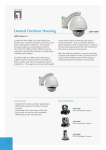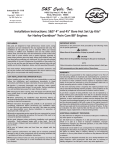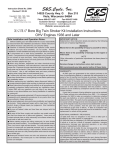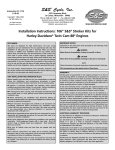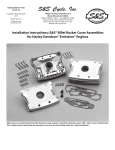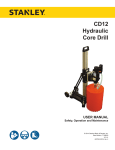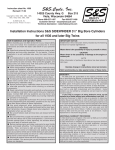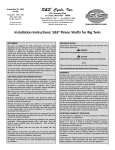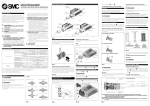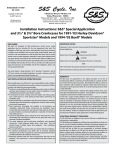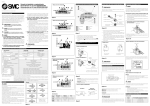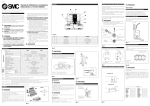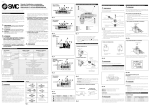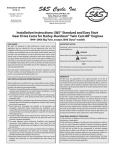Download - S&S Cycle
Transcript
® Instruction 51-1108 4-28-08 Copyright © 2008 by S&S Cycle, Inc. All rights reserved. Printed in the U.S.A. S&S Cycle, Inc. 235 Causeway Blvd. La Crosse, Wisconsin 54603 Phone: 608-627-1497 • Fax: 608-627-1488 Technical Service Phone: 608-627-TECH (8324) Technical Service Email: [email protected] Website: www.sscycle.com Because every industry has a leader Installation Instructions: S&S® Cylinder Heads for Harley-Davidson® Twin Cam 88® Engines DISCLAIMER: IMPORTANT NOTICE: S&S parts are designed for high performance, off road, racing applications and are intended for the very experienced rider only. The installation of S&S parts may void or adversely effect your factory warranty. In addition such installation and use may violate certain federal, state, and local laws, rules and ordinances as well as other laws when used on motor vehicles used on public highways, especially in states where pollution laws may apply. Always check federal, state, and local laws before modifying your motorcycle. It is the sole and exclusive responsibility of the user to determine the suitability of the product for his or her use, and the user shall assume all legal, personal injury risk and liability and all other obligations, duties, and risks associated therewith. Statements in this instruction sheet preceded by the following words are of special significance. The words Harley®, Harley-Davidson®, H-D®, Sportster®, Evolution®, and all H-D part numbers and model designations are used in reference only. S&S Cycle is not associated with Harley-Davidson, Inc. SAFE INSTALLATION AND OPERATION RULES: Before installing your new S&S part it is your responsibility to read and follow the installation and maintenance procedures in these instructions and follow the basic rules below for your personal safety. l Gasoline is extremely flammable and explosive under certain conditions and toxic when inhaled. Do not smoke. Perform installation in a well ventilated area away from open flames or sparks. l If motorcycle has been running, wait until engine and exhaust pipes have cooled down to avoid getting burned before performing any installation steps. l Before performing any installation steps disconnect battery to eliminate potential sparks and inadvertent engagement of starter while working on electrical components. l Read instructions thoroughly and carefully so all procedures are completely understood before performing any installation steps. Contact S&S with any questions you may have if any steps are unclear or any abnormalities occur during installation or operation of motorcycle with a S&S part on it. l Consult an appropriate service manual for your motorcycle for correct disassembly and reassembly procedures for any parts that need to be removed to facilitate installation. l Use good judgement when performing installation and operating motorcycle. Good judgement begins with a clear head. Don't let alcohol, drugs or fatigue impair your judgement. Start installation when you are fresh. l Be sure all federal, state and local laws are obeyed with the installation. l For optimum performance and safety and to minimize potential damage to carb or other components, use all mounting hardware that is provided and follow all installation instructions. l Motorcycle exhaust fumes are toxic and poisonous and must not be inhaled. Run motorcycle in a well ventilated area where fumes can dissipate. WARNING Means there is the possibility of injury to yourself or others. CAUTION Means there is the possibility of damage to the part or motorcycle. NOTE Other information of particular importance has been placed in italic type. S&S recommends you take special notice of these items. WARRANTY: All S&S parts are guaranteed to the original purchaser to be free of manufacturing defects in materials and workmanship for a period of twelve (12) months from the date of purchase. Merchandise that fails to conform to these conditions will be repaired or replaced at S&S’s option if the parts are returned to us by the purchaser within the 12 month warranty period or within 10 days thereafter. In the event warranty service is required, the original purchaser must call or write S&S immediately with the problem. Some problems can be rectified by a telephone call and need no further course of action. A part that is suspect of being defective must not be replaced by a Dealer without prior authorization from S&S. If it is deemed necessary for S&S to make an evaluation to determine whether the part was defective, a return authorization number must be obtained from S&S. The parts must be packaged properly so as to not cause further damage and be returned prepaid to S&S with a copy of the original invoice of purchase and a detailed letter outlining the nature of the problem, how the part was used and the circumstances at the time of failure. If after an evaluation has been made by S&S and the part was found to be defective, repair, replacement or refund will be granted. ADDITIONAL WARRANTY PROVISIONS: (1) S&S shall have no obligation in the event an S&S part is modified by any other person or organization. (2) S&S shall have no obligation if an S&S part becomes defective in whole or in part as a result of improper installation, improper maintenance, improper use, abnormal operation, or any other misuse or mistreatment of the S&S part. (3) S&S shall not be liable for any consequential or incidental damages resulting from the failure of an S&S part, the breach of any warranties, the failure to deliver, delay in delivery, delivery in non-conforming condition, or for any other breach of contract or duty between S&S and a customer. (4) S&S parts are designed exclusively for use in Harley-Davidson® and other American v-twin motorcycles. S&S shall have no warranty or liability obligation if an S&S part is used in any other application. Disclaimer: S&S® parts are designed for high performance off road, racing applications and are intended for the very experienced rider only. The installation of S&S parts may void or adversely effect your factory warranty. In addition such installation and use may violate certain federal, state, and local laws, rules, and ordinances as well as other laws when used on motor vehicles used on public highways, especially in states where pollution laws may apply. Always check federal, state, and local laws before modifying your motorcycle. It is the sole and exclusive responsibility of the user to determine the suitability of the product for his or her use, an the user shall assume all legal, personal injury risk and liability and all other obligations, duties, and risks associated therewith. Introduction S&S Super Stock® cylinder heads are designed to fit all HarleyDavidson® Twin Cam 88® engines. S&S heads can be used on stock 88”, 33⁄4” bore engines as well as 95”, 37⁄8” bore engines and all S&S 4” bore dual cam engines. The exterior dimensions of these heads are similar to stock and require no additional clearancing when replacing stock heads on engines installed in stock chassis. The combustion chambers are compatible with stock flat topped pistons and S&S pistons. Some S&S pistons are flat topped and some have a “pop up” dome to increase compression. Spark plug holes are in the stock location and machined to accept stock spark plugs. Special Features of the Major Kit Components: l l l l l 2 The intake and exhaust ports are a “cast to shape” design that yields approximately 30% more flow than stock heads. The special intake manifold required for these S&S cylinder heads has larger 1.780” I.D. runners to match the larger intake ports on the heads. The valve train components are designed to improve flow and work with any present day fuel. Clearances are set for any S&S camshaft with a lift of up to .640” without modification. S&S cylinder heads with the newer style short breather passage work only with S&S rocker covers. S&S rocker covers are compatible with stock rocker arms or aftermarket roller rocker arm assemblies. All S&S cylinder heads for Twin Cam 88® with 89cc combustion chambers are machined to accept the S&S compression release. Compression release machining is optional on heads with the 79cc combustion chamber. Installation of S&S electric compression releases requires the use of S&S die-cast rocker covers or similar rocker covers with a central hole or chimney. If heads are machined for compression release, but compression release is not used, a special plug #90-4916 must be installed in compression release hole in each head. The S&S cylinder heads for Twin Cam 88® have been strengthened with additional material in key areas. One such area is around the head bolt holes on the spark plug side. The head bolt washer pads for the two “outboard” head bolts is at the same level as the head bolt pads under the rocker cover. As a result, S&S heads for Twin Cam 88® use four identical long head bolts in each head instead of two long and two short head bolts. Kit Contents: l l l One set of S&S Super Stock® cylinder head assemblies complete with valves, valve springs, valve guide seals and keepers installed. Hardware which includes exhaust port stud flanged nuts, manifold mounting screws and washers, intake manifold O-ring seals, and exhaust pipe gaskets. Installation instructions. Additional items required for installation: Some of these items are included in S&S Hot Set Up KitTM or Super Sidewinder® packages. If the below items are not listed in the kit contents, they must be purchased separately. l S&S rocker covers. l S&S intake manifold. l Rocker cover gaskets, cylinder head and base O-rings, exhaust pipe gaskets and pushrod tube and alignment dowel O-rings. l Head gaskets. NOTES: l Since it is nearly impossible to anticipate every possible engine combination, it is the engine builder’s responsibility to check for proper running clearances. S&S considers checking and establishing all running clearances as standard engine building practice that must be performed during engine assembly. Engine failure due to improper clearances between moving parts is not covered under warranty. l Valve pocket reliefs in stock Harley-Davidson® pistons are smaller than those in S&S pistons. Valve to piston clearance should be checked if S&S heads are used with HarleyDavidson® pistons and high lift cams. If S&S heads have not been decked, valve to piston clearance is normally adequate with cams such as the S&S 585G, with TDC lifts of up to .186”/.179”. If cams with higher TDC lifts are used, clearance must be checked. l If S&S heads are used with S&S pistons no valve to piston clearancing is normally required. l If S&S 79cc heads are decked, valve to piston clearance should be checked. If Harley-Davidson® pistons are used with S&S heads that have been decked, valve pockets must be modified in nearly all cases. l S&S cylinder heads with 79cc combustion chambers have smaller valves than the heads with 89cc chambers. Heads with 79cc chambers have 1.940” intake and 1.575” exhaust valves. Heads with 89cc chambers have 2.000” intake valves and 1.605” exhaust valves. l Due to the larger valve sizes in S&S cylinder heads with 89cc chambers, the 89cc heads, will nearly always require valve to piston clearancing if used with Harley-Davidson® pistons. No clearancing will be required if used with S&S pistons. l Other S&S products such as adjustable chrome moly pushrods, cams, Hydraulic Lifter Limited Travel kit, and Super E and G carburetors which may enhance the operation of S&S Super Stock cylinder heads may be purchased separately. In some instances many of these parts are sold with S&S heads as part of a Super Sidewinder big bore kit or one of our popular Hot Set Up Kits. Installation Steps 1. 2. 3. 4. 5. #90-4916 plug and #50-7094 washer installed when compression releases are not used. Strip Motorcycle, Disassemble, and Inspect Parts Check Clearances and Install S&S® Cylinder Heads Finish Assembly of Top End, Install Carburetor and Replace Gas Tanks Engine Break-In Procedure (For installations that include new pistons.) Performance Notes. Installation Instructions Installation of an S&S Super Stock® cylinder head kit is easy and can be performed by any Harley-Davidson® repair shop equipped to do engine overhauls. No special tools other than those used in normal overhaul repair work are required. Read instructions thoroughly before starting work. When they are completely understood proceed with installation. 1. Strip Motorcycle, Disassemble, and Inspect Parts Follow Harley-Davidson® factory procedures outlined in Harley-Davidson® service manual for stripping motorcycle for top end service. NOTE - Disconnect battery and drain all gasoline from gas tanks before doing any work. WARNING Gasoline is extremely flammable and explosive under certain conditions and toxic when breathed. Do not smoke. Perform installation in a well ventilated area away from open flames or sparks. A. Remove gas tanks and all other parts required to perform top end service. B. Remove carburetor, rocker covers, pushrods, pushrod tube assemblies, and cylinder heads. NOTE - Be careful not to introduce any dirt or other foreign material into crankcase during disassembly of engine. CAUTION Metal filings, dirt and any other foreign contamination in engine may cause premature wear and/or irreversible damage to bearings and other internal engine components. C. Thoroughly clean and inspect all parts that are to be reused. Any parts that show signs of wear or damage should be replaced. D. If S&S compression releases are to be used, they should be installed in the new S&S cylinder heads at this time. Compression releases can be installed with the engine in the frame, but the procedure is much easier before the heads are installed. Install compression releases per S&S instruction sheets #51-1065 (manual) or #51-1109 (electric). If cylinder heads are machined for compression releases, but compression releases are not going to be used, #90-4916 threaded plug and #50-7094 washer must be installed in the compression release hole of each head and torqued to 30 ft.-lbs. See Picture 1. Picture 1 2. Check Clearances and Install S&S Cylinder Heads NOTES l Since it is nearly impossible to anticipate every possible engine combination, it is the engine builder’s responsibility to check for proper running clearances. S&S considers checking and establishing all running clearances as standard engine building practice that must be performed during engine assembly. Engine failure due to improper clearances between moving parts is not covered under warranty. l These instructions are for cylinder head removal and replacement only. If replacing pistons and/or cylinders, refer to the OEM or S&S Instructions for those components. CAUTION Contact between moving engine components may cause damage or destruction of the parts involved and produce abrasive particles which may cause damage or premature wear to other engine components. A. While applying pressure to hold cylinders in position, rotate flywheels so front piston is positioned at top dead center. Note where piston deck (See Figure 1) is positioned in relationship to head gasket surface. Piston deck (flat located just above top compression ring groove), not dome, must be flush with or slightly below gasket surface. If piston deck is higher than cylinder at top dead center, something is wrong and S&S should be notified. Dome (Pop-up) Deck Figure 1 NOTE - Stock and S&S engines are designed so that at top dead center, piston deck should be flush with or slightly below head gasket surface of cylinder. Piston to head clearance is provided by thickness of head gasket (.045” for S&S engines). 3 CAUTION D. 1. Insufficient clearance between piston domes and cylinder heads or piston domes and valves will cause damage to pistons and cylinder head components. B. Repeat procedure to check rear piston to cylinder gasket surface relationship. C. Check valve pocket fit. NOTES: l Valve pocket reliefs in stock Harley-Davidson® pistons are smaller than those in S&S® pistons. Valve to piston clearance should be checked if S&S heads are used with HarleyDavidson® pistons and high lift cams. If S&S 79cc heads have not been decked, valve to piston clearance is normally adequate with cams such as the S&S 585G, with TDC lifts of up to .186”/.179”. If cams with higher TDC lifts are used, clearance must be checked. l If S&S heads are used with S&S pistons no valve to piston clearancing is normally required. l If S&S heads are decked, valve to piston clearance should be checked. If Harley-Davidson® pistons are used with decked S&S heads, valve pockets must be modified in nearly all cases. 1. 2. 3. 4. 5. With cylinders and pistons installed, turn engine over until piston in front cylinder is at top dead center. Paint area around valve pockets on pistons with machinist’s blue. Place valves in cylinder head leaving off springs and retainers. Place head on cylinder and secure with one bolt. Lower valves until they contact piston. Rotate valve, marking painted area. Remove head and check points of contact. Valve should fit in valve pocket machined in piston dome. NOTES: l S&S recommends a minimum of .060” clearance between intake valve and piston valve pocket recess, and .080” between exhaust valve and piston valve pocket recess at piston TDC. l When checking valve to piston clearance pushrods must be adjusted so the hydraulic piston in tappet is bottomed in the tappet bore or on the HL2T washer if used. This insures that tappets can not bleed down so valve position will be accurate for clearance check. 2. 3. 4. 5. 6. Remove cylinders and install piston rings and wristpin clips per S&S Piston Instruction Sheet 51-1028. F. Coat piston skirts with engine oil and install cylinders. NOTE - Stock Harley-Davidson® Twin Cam 88® cylinder heads require two long and two short head bolts per cylinder. Stock short head bolts can not be used with S&S cylinder heads for Twin Cam 88®. The design of the S&S cylinder heads requires the use of four long head bolts per cylinder. All head bolts are the same length. Stock long head bolts can be used with stock length motors, but the short head bolts must be replaced with long head bolts Engines with longer than stock cylinders require four special length, long head bolts per cylinder. G. Clean threads of head bolts and cylinder studs. Spin each head bolt down on its respective stud to be sure threads are clean and free of contamination. H. Install head gaskets dry. S&S 33⁄4” bore heads gaskets require O-rings around the cylinder head locating dowels similar to stock head gaskets. S&S 37⁄8” and 4” bore head gaskets do not use O-rings around cylinder head locating dowels. I. Place one or two drops of oil on threads and under the head of each head bolt just prior to final assembly to reduce friction and insure accurate torque readings. Bolt heads on cylinders. Tighten bolts in stages using crossing pattern. See Figure 2. Top View Driveside 2 1 Rear Head Insufficient clearance between piston and valves may cause them to contact each other during operation resulting in damage to piston and valve train components. 7. 4 If insufficient clearance exists, remove piston and machine or grind valve pocket until head of valve fits flush with proper clearance. Repeat procedure for other cylinder head. Spread layer of putty into valve pockets in both pistons. Assemble cylinder heads and bolt on cylinders with head gaskets in place. Install rocker covers and pushrods. Adjust pushrods so the hydraulic piston in tappet is bottomed in the tappet bore or on the HL2T washer, if used. This insures that tappets can not bleed down, so that valve position will be accurate for clearance check. Turn engine over in normal direction of travel two complete revolutions. Disassemble engine and check thickness of putty in valve pockets. If insufficient clearance exists, machine or grind piston until proper clearance is achieved. Disassemble top end and clean all parts for final assembly. E. CAUTION 6. Check Valve to piston clearance at TDC. 3 4 1 2 Front Head 4 3 Camside Stage 1 S&S Head Bolts Stock Head Bolts 8 Ft.-Lbs. 7-9 Ft.-Lbs. Stage 2 18 Ft.-Lbs. 12-14 Ft.-Lbs. Stage 3 Turn additional 90˚ Figure 2 Turn additional 90˚ NOTE - Light coating of oil on head bolt threads minimizes friction so torque values are not distorted. It cannot be emphasized enough how important it is to do these steps carefully. Maintaining a good head gasket seal depends on it. CAUTION Improper torquing sequence and head bolt torque values may cause head gasket failure. Excessive torque values may cause studs to pull out of crankcase. 3. Finish Assembly of Top End, Install Carburetor and Replace Gas Tanks NOTE- There are two ways for the front S&S® 79cc head to breathe, through a vacuum port into the intake port or through the air cleaner. The position of a set-screw must be moved to change the breathing format. S&S 79cc front heads are delivered for vacuum breathing into the intake port, with the set screw installed in Hole 1. A. As delivered, the S&S 79cc front head is set up for vacuum breathing with the set-screw positioned in Hole 1. The rear head can only breathe through the air cleaner. This is the suggested breathing method for S&S 79cc heads. See Picture 2. B. If you choose to set the front head to breathe through the air cleaner, move the set-screw from Hole 1 to Hole 2. See Picture 1 and torque it to 20-36 in-lbs. E. If you are using the stock air cleaner, the through hole in the two breather screws must be enlarged using a 9/64 (.1406”) diameter drill. WARNING Do not use any other gasket than the supplied (10 pack, PN 90-4125) (2 Pack, PN 90-4120) .039” thick gasket on S&S 79cc heads. F. Follow Harley-Davidson® factory procedures outlined in Harley-Davidson® service manual to assemble rocker cover components and other parts that were removed for top end service. G. Assemble rocker arms, pushrods and pushrod tube assemblies and adjust pushrods. H. Install intake manifold using provided mounting flanges and O-ring seals. Be sure O-rings and flanges are assembled in correct sequence. See Figure 3. Figure 3 Use flange marked “F” on front head and flange marked “R” on rear. Slotted end of mounting flange goes toward lower manifold mounting hole. Flat washer provided is used on slotted end of flange. Hole 1 Hole 2 Picture 2 DANGER Do not run the S&S 79cc head with both Hole 1 and Hole 2 sealed. Also, Do not run the head with both Hole 1 and Hole 2 open. C. D. Gaskets for the front and rear heads are identical—but must be installed so that the “J-shaped” channel is positioned towards the intake manifold. (See Picture 1). This may cause one to be installed with the printed side facing up while the other is installed print side down. The print on the gasket is not a factor in its function. NOTES l The intake port diameters of S&S heads are larger than stock and require the use of an S&S manifold. l S&S compression releases cannot be used on stock HarleyDavidson® heads. They can only be used on S&S cylinder heads that have been specially designed and machined for them. l The intake port diameters of S&S heads are larger than stock and require the use of an S&S intake manifold and manifold seals. When used together, the S&S intake manifold and manifold seals still allow use of stock manifold mounting flanges. D. Install carburetor and air cleaner assembly using appropriate carburetor instructions. E. Reassemble gas tanks and all other parts that were dissembled during preparation for top end service. Be sure there are no gasoline leaks and that throttle opens and closes smoothly and snaps shut when released. NOTE - Throttle must not bind and must snap shut to fully closed position when released. The gasket included with S&S 79cc heads measures .039”—which is .019” thicker than other S&S gaskets that measure .020”. 5 WARNING E. The first 50 miles are most critical for new rings and piston break-in. Engine damage is most likely to occur during this period. Keep heat down by not exceeding 2500 rpm. Avoid lugging the motor, riding in hot weather or in traffic. Vary the engine speed. Do not lug the engine. We recommend changing the oil at 50 miles. F. The next 500 miles should be spent running engine no faster than 3500 rpm or 60 mph. Avoid continuous steady speeds, and do not lug the engine. Vary engine rpm. We recommend changing the oil again at 500 miles. If throttle does not return to fully closed position when released, it may inadvertently stick open possibly causing loss of control of motorcycle and personal injury to you or others. NOTE - Fuel needle and seat assembly must completely shut off fuel supply entering bowl. Fuel line connections must not leak. CAUTION Unwarranted gasoline leaking by fuel inlet needle may flood engine causing damage to components. WARNING Unwarranted gasoline leaks at fuel line connections and/or past inlet needle may flood engine and overflow on surrounding area creating fire hazard. 4. Lugging or running engine prematurely at sustained high rpm may result in damage to pistons and other engine components. S&S voids its guarantee if engine is not broken in properly. Engine Break-In Procedure NOTES: l S&S® engines are designed for high performance and as such are not as tolerant of inadequate break-in as stock or lower performance engines. Correct break-in will assure longer engine life and will prevent unnecessary engine damage. Engine damage caused by improper break-in is not covered under the S&S warranty. l If new pistons have not been installed, only steps A, B, and C are required. l If new pistons have been installed, all break in steps are required. A. Initial start up. Run engine approximately one minute at 1250-1750 rpm. DO NOT crack throttle or subject to any loads during this period as head gaskets are susceptible to failure at this time. During this time check to see that oil pressure is normal, that oil is returning to the oil tank, and that no leaks exist. B. Shut off engine and thoroughly check for any leaks or other problems. Let engine cool to the touch C. After engine has cooled, start up again and allow the motor to build some heat. Engine should be run no longer than three to four minutes. When the cylinders become warm/hot to the touch (approximately 150°) shut the motor down and let it cool to room temp. Follow the same cautions as for the initial start-up, and continue to watch for problems. D. 6 CAUTION Repeat this procedure 3 or 4 times. Each successive time it should take slightly longer to warm up and you can increase the temp slightly each time (+10°). You can be more liberal each time with the rpm, gently vary rpm continuously from idle up to 2500 rpm in the final cycle. Don’t be too concerned with final carb settings at this time because idle speed and mixture cannot be correctly set until the motor reaches full operating temperature. The motor should not reach that temperature during these cycles. Do not allow engine temperature to become excessive. After completing the initial series of heat cycles, the engine is ready for final carburetor adjustments and the 500 mile engine break-in process. 5. l l l l G. For the balance of the first 1000 miles the motor can be run in a normal but conservative manner. You can be more liberal with the rpm range and motorcycle can be operated at normal highway speeds. Avoid overheating or putting any hard strain on the engine: no drag racing, dyno runs, excessive speed, trailer towing, or sidecar operation. H. After 1000 miles, verify carburetor jetting and adjustment. Change the engine oil. Motorcycle can now be operated normally. Performance Notes Ignition system - For Harley-Davidson® Twin Cam 88® engine kits, we recommend that an aftermarket or high performance ignition module be used. Engines built with S&S kits have higher than stock compression ratios, performance cams, and in some cases cylinder heads with combustion characteristics that are different from stock. These and other factors effect the ignition requirements of the engine. Programmable ignition systems allow ignition maps to be optimized for a specific application, but should be programmed by a qualified technician. Consult the ignition manufacturer for recommendations regarding use of a specific ignition system with large displacement, high compression engines. Spark plugs - Use spark plugs and wires that are compatible with the ignition system. Dual plug installations in S&S Super Stock® heads are not generally necessary. All S&S test engines are run using S&S carburetors. S&S Super E and G carburetors are recommended for most applications with the Super G being used more often on larger displacement, freer breathing engines with higher compression ratios. Typically, engines equipped with S&S heads require the same or slightly leaner jetting than those engines fitted with stock heads. Consult the carburetor jetting instructions for specific jetting recommendations. If a brand of carburetor other than S&S is used, it must be made to run rich enough to operate properly and to prevent engine damage. Any technical questions regarding use and adjustment of carburetors other than S&S should be directed to the manufacturer. This includes S&S carburetors that have been modified by a third party. l l If the motorcycle is used exclusively on a drag strip where engine temperatures vary, slightly richer jets may be necessary for best performance. Larger jets/richer mixtures will enable one to run a colder engine which is sometimes desirable. This is best determined by experimentation. Carburetor jetting and spark plug color - While spark plug color may be used to help determine carburetor jetting, S&S recommends that our instructions be used as primary jetting guide and that plug color indications be used only as secondary aid. We have found that different brands of gasoline, gasoline additives, engine heat (due to ignition timing), and brands of plugs and heat range used distort plug color drastically making plug reading difficult for the average tuner. Also, new plugs usually require a road test of 10 miles or more to properly develop the color which means that quarter mile tests may not be long enough and hence, not always a good indication of carb jetting. It is best to use recommended spark plug type and to consult the spark plug manufacturer if you have questions. Exhaust Systems l Drag pipes - While drag pipes can be used with good results to achieve top end horsepower, they are generally not recommended for street applications. Carburetor adjustment and jetting is generally easier for engines with muffled exhaust systems. l Muffler systems: Most stock and many aftermarket exhaust systems are made exclusively for looks with little consideration given to performance. A very good street system consists of the stock header pipes with the crossover tube and a set of low restriction mufflers. S&S® slip-on mufflers are designed to maximize the performance potential of S&S cylinder heads. The benefit of S&S Slip-on mufflers is two-fold: they replace the restrictive, power robbing stock mufflers on an otherwise good set of header pipes, and since they use the stock header pipes, there is no concern over whether or not a complete new system will fit properly. Low restriction mufflers and stock header pipes will produce more power than than drag pipes in the midrange. Since the midrange is where the vast majority of normal driving occurs, it makes this system ideal for the street. Gearing l Gearing depends on the total weight of the machine and rider, the size of the engine, cam, exhaust system and type of riding to be done. Most high performance engines, and particularly those with larger displacements, are capable of pulling more gear. We suggest you break the engine in with stock gearing to minimize the load on the engine. After the engine is broken in, you will have a better feel of its potential and can change gearing accordingly. l For those who wish to determine their final drive gear ratio the formula is as follows: Engine Revolutions Per One Revolution of Rear Wheel= (Clutch Sprocket*) x (Rear Wheel Sprocket*) (Motor Sprocket*) x (Transmission Sprocket*) * Number of teeth on each sprocket. Compression l Generally speaking, while engines with higher compression ratios make more horsepower and perform better, they also tend to lose that performance edge faster, require more maintenance, are harder to start, and require better gasoline. As a rule, we recommend a compression ratio of no greater than 11:1 for engines used in normal street operation. A word of caution is in order. Before building an engine that may be unsuitable for your application, carefully consider your riding needs, riding style and overall performance objectives. 7 Replacement Parts for S&S® Cylinder Heads for Harley-Davidson® Twin Cam 88® Use this line drawing to identify the replacement part number required. Parts interchangeable with stock Harley-Davidson® parts are listed with the Harley-Davidson® number of the parts they replace. If no Harley-Davidson® number is provided, the S&S part cannot be used as a direct replacement for the Harley-Davidson® part and vise versa. Year groups listed apply to S&S parts only; do not attempt to identify stock Harley-Davidson® parts by these groups. Abbreviation “NS” means part is not shown in diagram. All reference to Harley-Davidson® part numbers is for identification purposes only. We in no way are implying that any of S&S® Cycle’s products are original equipment parts or that they are equivalent to the corresponding Harley-Davidson® part number shown. 1. 2. Head bolt washer 17. (See S&S catalog for replacement cylinder Cylinder head - All S&S for Twin Cam 88® .100” . . . . . . . . . . . . . . . . . . . . . . . . . . . . .50-7088 18. heads, cylinder head sets, and kits.) .250” (H-D® #6016) . . . . . . . . . . . . . . . . .50-7091 33⁄4” x .046” . . . . . . . . . . . . . . . . . . . . . . .93-1045 Exhaust port stud - (H-D® #16715-83) 37⁄8” x .046” . . . . . . . . . . . . . . . . . . . . . . . 93-1044 Valve 9. 10. Intake - 2.000” dia. . . . . . . . . . . . . . . . . .90-2000 11. Nut, HSFH - ⁄16 -24 (H-D #7593) . . . . . .50-5025 19. Exhaust - 1.605” dia. . . . . . . . . . . . . . . .90-2001 12. Exhaust pipe gasket (H-D® #65324-83) 20. 79cc chamber Intake - 1.940” diameter. . . . . . . . . . . . .90-2025 13. 14. Valve seat 89cc chamber Valve guide - Intake or Exhaust Standard (H-D® #18112-92) . . . . . . . . . .90-2210 +.001” (H-D® #18130-83C) . . . . . . . . . . .90-2211 +.002” (H-D® #18133-83A) . . . . . . . . . . .90-2212 +.003” (H-D® #18131-83C) . . . . . . . . . . .90-2213 +.030” . . . . . . . . . . . . . . . . . . . . . . . . . . . .90-2219 Valve spring shim .015” . . . . . . . . . . . . . . . . . . . . . . . . . . . . .90-2086 .030” . . . . . . . . . . . . . . . . . . . . . . . . . . . . .90-2087 Valve guide seal - Intake or Exhaust (H-D® #18001-83A) . . . . . . . . . . . . . . . . .90-2008 Valve spring kit .640” lift - steel top collars . . . . . . . . . .90-2077 .640” lift - titanium top collars . . . . . . .90-2078 8. Head bolt assembly All S&S Twin Cam 88® (includes head bolt washer) 88”, 95”, 100” & 107” incl. washer #50-7088 . . . . . . . . . . . . . . . . . . . . . . . . . . . . . . . . .93-3030 116” incl. washer #50-7091 . . . . . . . . . .93-3037 8 23. Head mount bolt .507” x .705” x .047” . . . . . . . . . . . . . . .50-7094 ⁄8 -16 x 11⁄4” - (H-D® #4716W) . . . . . . . . .50-0168 3 Flat washer - 5⁄16” (H-D® #6016,6702) . .50-7034 Manifold mounting flange Rear (H-D® #27010-86A) . . . . . . . . . . . . .16-0233 All 7. Manifold mounting screw Washer, compression - 14mm Exhaust - 1.605” diameter. . . . . . . . . . .90-2003 Exhaust - 1.575” diameter. . . . . . . . . . .90-2028 6. Plug, HH - 14mm, . . . . . . . . . . . . . . . . . .90-4916 22. Front (H-D® #27009-86A) . . . . . . . . . . . .16-0232 Intake - 1.940” diameter. . . . . . . . . . . . .90-2027 5. (Refer to manifold section of S&S Catalog.) 21. Intake - 2.000” diameter. . . . . . . . . . . . .90-2002 79cc chamber 4. 16. O-ring, Alignment dowel, Head (33⁄4” bore only)- . . . . . . . . . . . . .50-8008 Intake manifold - HH - 5⁄16 -18 x 1” (H-D® #3987,4017) . . . .50-0108 15. Alignment dowel - base and head . . .50-8177 Base (All bore sizes) SH - 5⁄16 -18 x 1” (H-D® #3201WA) . . . . .50-0101 Exhaust - 1.575” diameter. . . . . . . . . . .90-2026 3. ® . . . . . . . . . . . . . . . . . . . . . . . . . . . . . . . . .93-1005 Intake .085” longer - 2.000” dia. . . . . .90-2004 Exhaust .085” longer - 1.605” dia. . . . .90-2005 5 Head gasket - 4” x .046” . . . . . . . . . . . . . . . . . . . . . . . .93-1043 . . . . . . . . . . . . . . . . . . . . . . . . . . . . . . . . .50-8082 89cc chamber Manifold O-ring seal . . . . . . . . . . . . . . .16-0235 24. Flat washer - 3⁄8” - (H-D® #6019) . . . . . .50-7051









